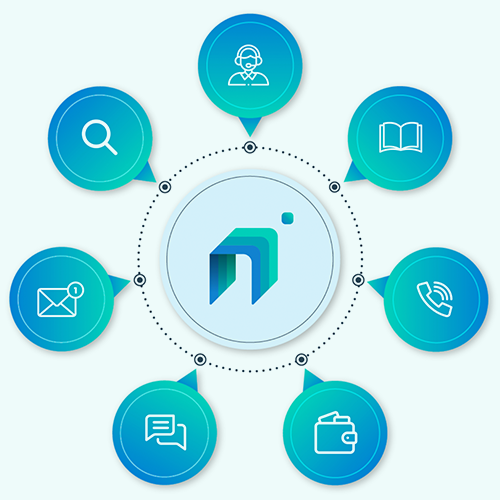Conversational banking is redefining how banking and financial institutions engage with users more conveniently.
Every bank offers similar products and services in the banking industry, whether it is a public/private sector, small/big, or local banks.
As offerings are same with every bank, experience and satisfaction customers have with their banks play an important role in being with a bank.
In recent times customer satisfaction matters more than ever before in banking sector. One awful experience for a customer with a bank is enough to shift to another bank because nowadays, customers are accomplishing more and more on digital channels at their fingertips.
Banks often fail to intercept reasons for lower customer satisfaction rates. As a result, it is tough to keep up a long-term relationship with existing customers.
Therefore, it is essential for banking organizations to understand and determine reasons behind low customer satisfaction scores.
Banking industry needs to figure out a technological solution to improve CSAT. Among all available solutions, Conversational banking is a solution that can increase customer satisfaction levels.
Customers expect human-like intelligent conversations when they try to interact and solve their issues; they want to be heard wherever and whenever they need it.
Use of conversational AI in banking helps customers in their day-to-day banking operations without human intervention/assistance.
Now, let’s get into the core concept without any further delay.
What is CSAT?
“Unless you have 100% customer satisfaction, you must improve.” [Source:Horst Schulze]
CSAT measures how well a customer’s expectations concerning a product or service provided by a company have been met, falls short, or exceeded.
Every business measures customer satisfaction differently. Few companies calculate based on rating cards, number of retention activities and repetitive customers, and few based on feedback forms.
Regardless of all, customer satisfaction can be divided into good and bad or happy and unhappy. CSAT scores can help businesses to predict churn in customer experience but cannot predict customer retention.
Reasons for lower customer satisfaction in banking enterprises
Lack of Interpersonal Communication
Relationship building is very crucial in banking industry. Banks shifted to digital platforms to reduce business costs and save time for customers, but banks lack interpersonal communication.
Providing a digital solution to customers is a right strategy, but a bank should know more about customers before pushing a product or service. So, for banks, it is good to have interpersonal communication with every customer.
Traditional call centers
Few banking organizations feel advancing a call center with the latest technology is a cost. In reality, a contact center is a safety net. It is helping banks in improving customer experience. When a bank is not showing much interest in advancing the contact center, it can do more harm than good.
While a bank contact center cannot reach customer’s expectations automatically, that bank will start failing to satisfy its customers.
Improve CSAT in banking processes using conversational AI
Banking industry has gone through many technological transformations, and it is continuing. From using ledger books to desktops, desktops to mobile and internet banking, and finally conversational banking led by artificial intelligence.
Conversational assistants (Chat/voice) are built to offer superior customer engagement, experience, and satisfaction.
Majority of organizations (74%) feel conversational assistants are crucial enablers of a company’s business and customer engagement strategy. 49% of retail banking and insurance organizations deployed chat assistants on their web and mobile platforms.
Now, let us look deep into how customer satisfaction can be increased in each banking process using conversational AI.
24/7 Self-service customer engagement
With many mobile technology advancements, information reached customers’ fingertips, making users addicted to self-service.
Both a prospect and customer expect conversational banking operations that offer 24/7 self-service customer engagement.
Suppose a prospect wants to open a new account (savings/current) without marching to a bank. At that time, a prospect will have multiple FAQs in mind, which need to be cleared to open a new account.
With traditional banking processes, a customer must reach a physically operating bank. At that point, customer needs a bank that opens a new account via online.
If your bank has an intelligent chatbot, that prospect will clear all queries, open an account, and become a customer for your bank.
It is good for a bank to make a positive impression in the first interaction with a customer.
When a customer is satisfied with offered banking services, it is clear that the customer will not show much interest in shifting to another bank.
Whenever a new prospect becomes a customer, that customer life cycle begins from that point.
There will be a massive number of customers for a bank. As customers are more, traffic to banks and contact centers will be high to clear their queries and to perform day-to-day transactions (cash deposit, cash transfer, bank statement, loan application, EMI payments, and many more).
With mobile and internet banking, number of customers rushing towards banks has decreased.
Still, customers required a simplified solution to complete their day-to-day banking operations with minimal efforts and seamlessly.
When a customer wants to transfer cash to a friend using mobile or internet banking, a customer has to go through various steps like login into account, add receivers bank details, enter amount details, and click on pay.
Then it gives you a prompt to confirm; after that customer needs to enter OTP to complete that transaction.
It takes at least two to three minutes to complete a single transaction, which many customers hate. It can be one of reasons for decreasing CSAT.
When customers want to clear their queries, they reach out to a bank physically or customer care to solve their issue. But, it takes much time to solve their problem that leads to low customer satisfaction.
It is all happening because banking and financial services are still using traditional methods. So, banking enterprises need to shift to conversational banking. By shifting to conversational banking, banks can offer 24/7 self-service to customers by which a customer can complete day-to-day banking operations in less than a minute.
Customers can clear their queries whenever required (24/7) via text or voice using their preferred natural language.
With conversational banking, banks can improve customer engagement that directly improves customer satisfaction rates.
Instant problem solving with contact center
Customers are reasonable, and they are looking for quick and effective problem-solving.
Customers are aware that problems or mishaps will occur once in a while, but they expect to fix it asap by banks.
Let us take a case:
A customer lost a credit card, and that card needs to be blocked immediately. As it is a holiday, a customer can not walk into a bank but wants to block that card. For a user, the next available option is a contact center.
If a customer can connect to a contact center in seconds, he can close it immediately. But, connecting a call to a contact center is a challenging thing for customers with traditional IVRs.
Even after connecting, it takes much time to talk with a human agent. That agent will transfer that call to credit card department to close it, where a customer gets frustrated and irritated with time spent on a simple task, which leads to low customer satisfaction.
It’s all happening because banking enterprises are still using traditional contact centers (IVRs and routing systems).
By shifting to conversational banking, a customer can block a credit card right away within seconds by talking/texting with intelligent chatbots. That makes a customer relaxed and satisfied with immediate problem-solving.
Once a customer receives top-quality customer services from a bank, CSAT level will automatically increase that binds customers with a bank.
Personalized banking
Customers expect to be treated as they are essential for a bank. Relationship between a customer and bank has a noticeable impact on customer satisfaction rate.
Customers want to build a great relationship with their operating bank rather than just a random customer. A customer expects a bank to offer personalized services and products apart from just pushing.
With traditional banking processes, it is impossible to offer personalized banking services to every customer.
But, with Conversational AI, a bank can offer personalized service.
By moving to conversational banking, banks can analyze and understand customer choices and preferences. As banks have intelligent bots, they will react based on a customer with whom it is talking.
These cognitive bots will offer products that please customers very much that increases csat levels in a customer. It also helps in increasing brand loyalty, trust, revenue, customer engagement, and retention.
Consistent Omni-Channel Experience
In modern banking, customers have numerous ways to interact with a bank, such as internet and mobile banking, phone, and ATM.
Whenever a customer tries to interact with these touchpoints, customers experience an inconsistent experience that is letting down customer satisfaction rates.
Banks can offer consistent customer experience across all available channels by opting for Conversational AI technology and integrating it on bank platforms.
Conversational banking offers an omnichannel experience that provides an excellent customer experience for every customer across every channel, whether mobile, web, app, etc.
With omnichannel experience, a customer can stop a conversation on one platform and can continue the same conversation on another platform without breaking flow.
While a customer interacts with conversational banking chatbots, there is no need to explain everything from scratch with a human or chatbot.
Till we reach a 100% customer satisfaction rate, there is a scope for banks to increase it.
Are you a banking enterprise and finding it challenging to provide an excellent customer experience for your customers?
Then it’s the right time to reverse engineer and fix issues.
If the issue is “traditional way of banking,” then it’s time to switch to conversational banking.
As discussed above, conversational banking helps a customer in every banking process.
By offering such a great experience at every stage, there will be an impeccable impact on banking revenue, customer retention, and brand loyalty.
So, think and switch.
Any more queries about conversational banking and customer engagement, contact us.
We are here to help.









